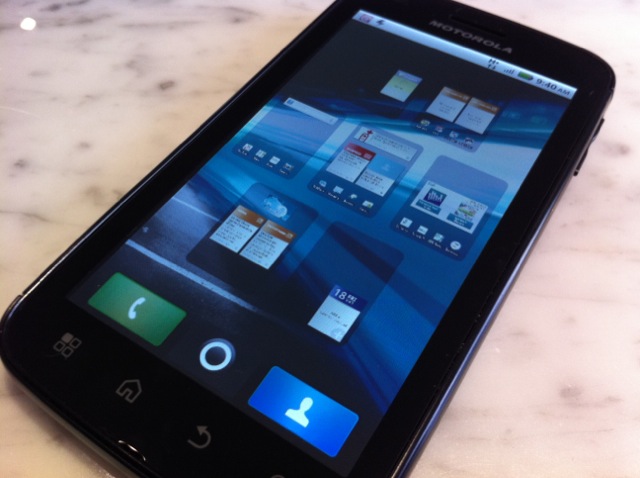
The Motorola Atrix is your dream phone, at least on paper. The phone that doubles as a netbook that triples as a media center, it is Motorola’s superphone, and heralds the beginning of the dual-core era.
With dual-1Ghz Cortex A9 processors, 1GB RAM, 16GB internal storage, a 960×540 pixel qHD display, 5MP camera with flash, 720p video capture, front-facing VGA camera and fingerprint scanner, the specs blow away any other device on the Canadian market, including the iPhone 4. And make no mistake, the iPhone is its greatest competitor. But the Atrix is a pre-emptive attack on Apple’s phone next-gen phone and the upcoming inundation of dual-core Android phones and tablets. It reeks of ambition, but treads cautiously between consumer, enterprise and enthusiast device.
But does the Atrix deliver a comparable experience iOS? Should it? Can its Motoblur skin atop Android 2.2 compete with iOS, or even with HTC’s beloved Sense UI? Read on to find out!
The Phone:
At first glance the Atrix appears quite utilitarian: no HTC-like flourishes, no Samsung-like chins. Its entire body is made from a rigid, brushed plastic, and while it resembles aluminum, it lacks the metal’s satisfying heft and underlying rigidity. Since the battery cover is quite thin, Motorola smartly designed it to wrap around the top and bottom of the device. Weighing 135g, the Atrix is no RAZR, but sits comfortably in the hand, and feels significantly lighter than the iPhone 4’s 137g. I would have preferred better materials in exchange for a slightly heavier product, and likely a higher price.
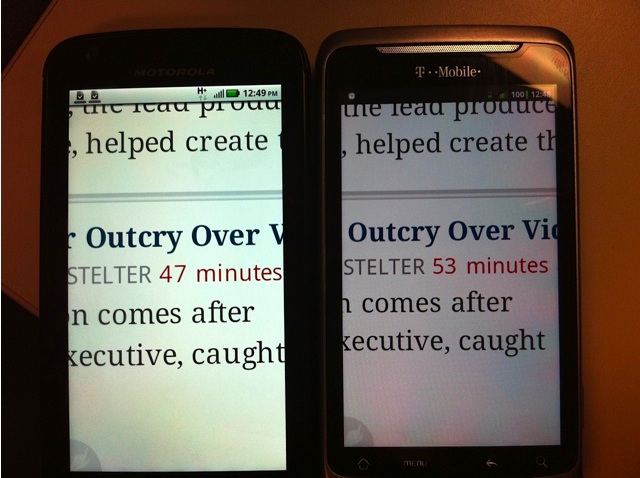
The 4” screen is one of the highest resolution LCD displays on the market. It lacks the “retina”-calibre pixel density of the iPhone 4, but is no slouch. There is a muted tone to the colours, but brightness, contrast and black levels are excellent. I’d still take the lower-resolution-but-better-contrast Super AMOLED screen from the Galaxy S over this one, but Motorola have made excellent use of the increased pixel count. They have raised the LCD density in order to fit more onto the screen, and due to the higher number of pixels, text is comparatively smaller but wonderfully legible. Images are crisp, and the 16:9 widescreen ratio is perfect for movies. Viewing angles are quite good too, but the glossy glass is very reflective.
The rest of the device is fairly unremarkable: the right side houses the small and thankfully delineated volume rocker; the left the USB and HDMI ports. The power button, which resides on the top rear portion of the device, doubles, when enabled, as a fingerprint scanner. At first I found the power button placement a source of frustration, since I naturally rest my thumb on the volume rocker when pressing the power button with my index finger. After getting used to it, I’m starting to wonder why other manufacturers don’t place theirs behind the screen, too. It just feels natural.
After calibrating the device and swiping your right and left index fingers across the sensor, it unlocks the device with a satisfying vibration. Problem is, the scanner is extremely sensitive, and protests tersely if your swipe is incomplete, which happens all too often. Notable, too, is the addition of a notification LED on the front of the device next to the front camera, blinking a solid forest green when it has something to tell you.
The back of the device is lovely – untextured and bare, with a repeating diagonal block design. While glossy and smooth, it’s got sufficient grip to prevent easy slips.
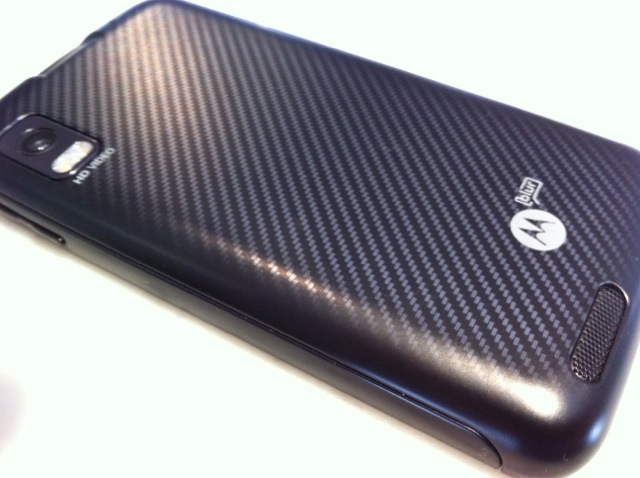
The Hardware:
The Atrix is one of the first devices on the market that runs nVidia’s Tegra 2 SoC, a dual-core CPU combined with a very capable GPU. It’s readily apparent, however, that when browsing through the Android 2.2 UI that extra core is not being utilized. In fact, Motorola has somewhat burdened the stock Android experience with its Motoblur overlay, though somewhat less than on previous devices.
Motoblur now consists of a custom launcher (which is actually quite nice) and a few removable widgets, consolidating messaging, social networks, email, news, photos, etc. But the experience doesn’t feel consistently smooth. Occasionally jerky, it’s a significantly improved experience to previous generations of Motorola devices, but you have to wonder how HTC has gotten it right for three generations. The vast majority of the time, however, the UI responds instantaneously, as much of the underlying Android framework is unchanged from stock OS 2.2 Froyo.
It’s not until you benchmark the Atrix, or play a graphically-intense game, that the benefits of two cores and 1GB of RAM emerge. Included demos of Asphalt 5 and Let’s Golf load quickly and perform superbly. Graphics-intense games like Tank Hero took half the time to load as my G2 (HTC Desire Z) and performed almost twice as fast. In fact, the Atrix took anything I threw at it effortlessly.
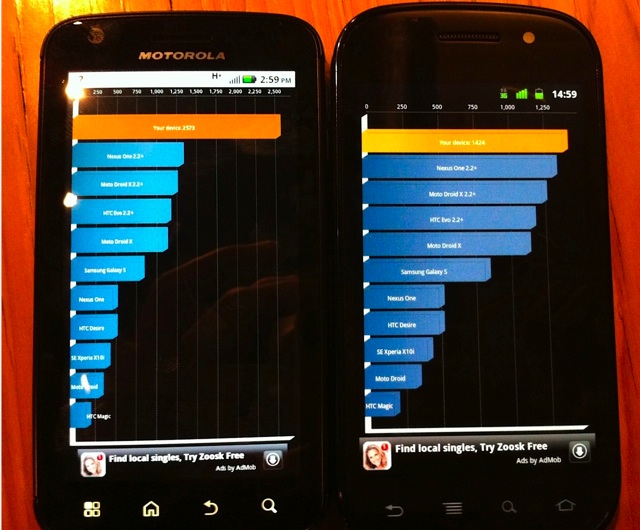
It received a 2573 on the Quadrant Standard benchmark, compared to a 1424 on the Nexus S and 1735 on my overclocked G2. It consistently scored over 35MFLOPS in the Linkpack for Android benchmark (even though the app doesn’t utilize both cores in the device) compared with the Nexus S’ 14.2MFLOPS. It completed the Sunspider Javascript benchmark in 4382.1ms, while the Nexus S took 6077.8ms (both running xScope Pro browser).
(note that the Nexus S is not optimized for Linpack or Quadrant, but is used as a base for good benchmark performance)
In other words, the device is already faster than any Android device released so far in Canada, and that’s running Froyo with apps that haven’t been updated to take advantage of both cores.
The Motorola Experience:
Motoblur is a contentious word. Some people love it – most don’t. I think Motorola realized that they had two types of people using their phones – feature phone users upgrading to a Cliq or Backflip, and another, the more hardcore user, who saw the beautiful simplicity of a Droid or Milestone running stock Android. In an effort to appease both and perhaps widen the berth of the Atrix’s demographic, they decoupled Blur away from OS and focused in on usable widgets and value-add apps.
In this sense, they did a good thing: paring down the experience until it was recognizably Android, while improving the aspects that were somewhat lacking, namely the social networking integration and overall UI fluidity.
You will need to make a Motoblur account to use the phone. Since, for Android to be at all useful you also need a Google account, you may as well use your Gmail address. Motorola then prompts you to link as many services to it as you can: Twitter, Facebook, Exchange email — even Photobucket — accounts can be plastered over one, or many, of your seven home screens. Whereas before your interaction with these widgets was limited, they are now rather useful. They allow you to swipe through your various updates and emails, responding inline. While they may not be as attractive, or provide the features of, a dedicated Twitter widget or Picasa app, for the novice they allow access to essential information, and for the pro, are good enough to consider keeping. I especially like the Exchange mail client, which is anaemic on stock Android.
Strangely, Motorola has decided to replace some Android apps with their own, and keep, or only slightly alter, Google’s native applications. The calendar and messaging apps seem the same, while the contacts app tries to be everything to everyone, consolidating all your services’ into one disorganized mishmash: every Facebook, Twitter, Gmail, Exchange and Hotmail contact is grouped together by default, though thankfully you can sort by service.
Along with the Motorola fixtures like a DLNA app, Quickoffice, Phone Portal (a wireless portal to connect to the phone via WiFi), and Media Share (share media between devices), Bell throws in some apps to the mix. Kobo eBook reader, Qik Messenger and their ubiquitous TV&Radio/PVR Remote bundle have been tossed in. Not an offensive amount of bloatware, though we’d prefer the ability to delete them.
The included multitouch keyboard is attractive, but more often will not register button presses, forcing me to manually correct the word. In my experience, HTC is the only company whose included keyboard isn’t worth immediately scrapping. Do yourself a favour and download one of many superior alternatives from the Marketplace.
Performance:
The Atrix feels faster than any device I’ve ever used, and that includes the iPhone 4. It is, and will continue to be the phone to get if you want sheer speed. Apps load instantaneously, multitasking actually feels like such, and there’s a general sense of space. In other words, you never feel like you’re taxing the phone.
The Tegra 2 processor inside the Atrix is certified for what nVidia calls the Tegra Zone, a portal for users to download dual-core optimized games. There are several updated games in the Marketplace – even namestays like Fruit Ninja – that have been optimizd for nVidia’s platform. This is just another way that vendors, carriers, and manufacturers are marrying specific hardware to specific software (see HTCSense.com, Samsung Apps, Sony Ericsson Playstation, etc.), perhaps forcing users to pay again for software they’ve already bought.
This is the first Android device I’ve used that approaches a fluidity and stability similar to iOS. Other reviewers have stated they experienced instability and sluggishness with the UI, but I have had none of those symptoms. Just keep your fingers out of the included Task Manager app, and let the OS do the RAM pruning.
As stated earlier, browsing on the Atrix is very fast, especially since the device takes advantage of Bell’s HSPA+ network, which has a maximum download speed of 14.4Mbps. The default browser will suffice, but for added features, download Dolphin Browser HD or Skyfire. Flash 10.1 is bundled with the phone, and it performs well enough, though I think any inconsistency that you’d experience is a fault of the code, not the speed of the hardware. I found certain higher-quality videos still hiccupped occasionally, but it’s a night and day difference when compared to earlier generations of hardware like the Nexus One or Milestone. Overall, the browsing experience reaches an almost desktop-like robustness. The 1GB of RAM allows for a greater number of tabs to be saved without having to reload them.
Camera:
The 5MP camera on the Atrix does pretty well in low light, which is the benchmark I use to determine sensor quality in phones these days. There is a fair amount of noise, even when using the flash, but is likely due to software tweaks to enhance detail. In daylight situations the camera is excellent, with accurate colour tones and sufficient detail. The iPhone 4 has a far superior lens, especially for low light shots.
The dual LED flash is quick and powerful, though like most phone cameras, due to the fixed-length lens, it tends to overexpose at close proximities, and is insufficient for large rooms.
Video quality was equally grainy, even in well-lit situations, and once shooting begins the focus is fixed, which is a disappointment. Overall quality, however, is good, and scales to a 720p television quite nicely. I’d take a softer result for a decrease in noise, but this seems to be a trend lately with phone cameras.
The VGA camera on the front of the Atrix will do in a pinch, though it produces some of the grainiest photos I’ve ever taken. So too does Android’s video calling experience pale in comparison to Facetime on iOS, but Qik, the included conferencing app, is one of the best current options for Android users.
I honestly expected more from Motorola: they don’t seem to have upgraded their lens since the original Droid.
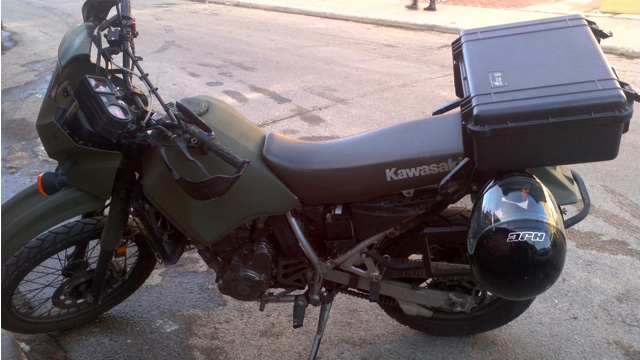

Battery:
The 1930mAh battery is some 400mAh larger than most phones released on the market today, and it shows. With normal use, the Atrix lasted over a day and a half, and I rarely worried about running out of juice. Specifically, the Atrix lasted for 11.5 of medium-to-heavy use.
In fact, I used the Atrix on a 3-hour conference call and the battery only declined 20% in that time. Considering the battery is removable, I wouldn’t hesitate to recommend this device for travellers and power users. Very impressive battery life.
Call Quality and Download Speeds:
The Atrix has excellent voice quality, and my callers assured me that my voice was clear and distortion-free. Reception was excellent wherever I went in the GTA.
Download speeds consistently averaged 2-4.5 Mbit/s but it seems that, like the AT&T version, the Bell Atrix is not HSUPA-enabled. While the hardware physically supports higher speeds in the upload, the device maxed out at around 450Kbp/s. Hopefully, like AT&T is claiming to be working on, Bell will shortly enable HSUPA speeds of 5.76 Mbit/s. To its credit, the Atrix didn’t feel significantly slower in the upload than any device I’ve used recently on Bell’s network, but this is not going to sit well with customers looking to take advantage of that huge bandwidth margin available to them.
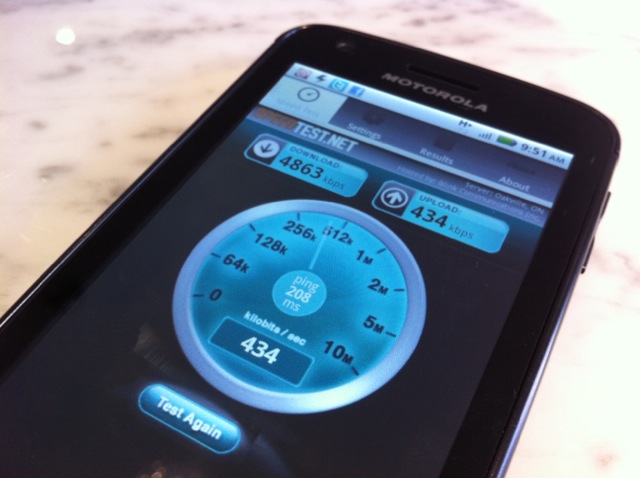
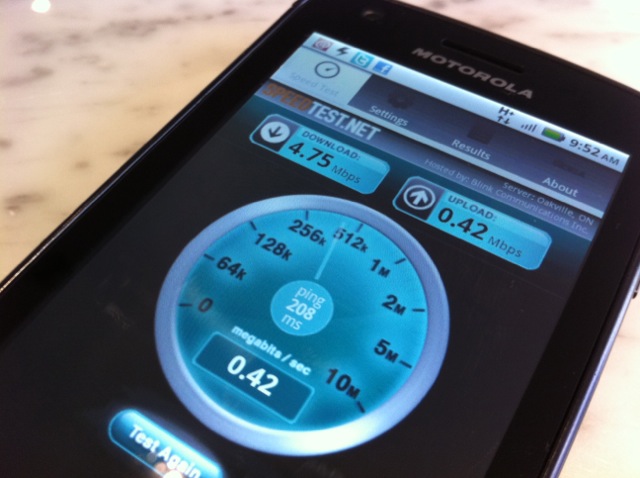
Accessories:
The Lapdock is a very curious add-on, since it claims to provide laptop-like functionality powered by a smartphone. In truth, it loads a portion of the Atrix’s internal storage running a limited Linux variant. Its a very limited feature-set, namely a full-screen Firefox browser, a dedicated media center, and access to the Atrix’s phone and messaging functions in either docked or fullscreen mode.

The quality of the Lapdock is excellent: brushed aluminum and very lithe, it’s most comparable in build to the MacBook Air line, though don’t go near it if you’re looking for the same experience. Opening more than two tabs in Firefox brings the lapdock to a crawl, and there is pitiful else to do with the 11” display. The prospect of scaling up an Android app to such proportions was not attractive on paper, and frustrating in reality. It’s not feasible to interact with a touch-based app with a traditional laptop input. You can use one of the two USB inputs to attach a mouse, but I found the experience largely underwhelming. More useful is the ability to attach a USB printer to the dock.
The Media Center is a fluid, attractive fullscreen app powered directly from the Atrix. It performs the basic function of aggregating all the media on the phone, including photos, music and movies, and plays back HD video without issue. At $329.95, the dock is only slightly cheaper than a dedicated netbook capable of exponentially more, and as a result I cannot recommend the Lapdock.

The HDMI Multimedia dock, on the other hand, is a very handy accessory, though overpriced at $129.95. It provides a media interface to the Atrix’s multimedia functionality, aggregating music, photo and video across the included HDMI cable. Considering you can augment the included 10GB of usable internal storage with a 32GB microSD card, as well as stream media over WiFi using a myriad capable Android apps, it’s a competitive and attractive alternative to a dedicated media server. The remote – like the interface — is simple and sparse, but does the job. Your choice, however, if Motorola synergy is a compelling enough reason to get this over a similar, and likely more capable, alternative.
Downsides:
Besides the accessories, there are some knocks against this piece of hotness. Actually, let’s start there. This phone gets hot – uncomfortably so – which alone probably precluded a metal battery cover. After a few minutes on a call, or playing Dungeon Hunter HD, you’ll likely need to put the phone down.
And while the build quality is fine, its closest comparison would be the Nexus S, which is a backhanded complement. Obviously cutting down on costs, and a few corners, Motorola skimped on the battery cover material as well as the buttons, which feel flimsy and potentially breakable. The power button position is hard to reach at the best of times, and is not seated straight, a small but condemnable oversight in quality control.
Worse yet, but perhaps most forgivable, is the release of a brand new phone running old code. Froyo, Android 2.2, is almost a year old now, superseded by a newer phone version (Gingerbread) and dedicated tablet version (Honeycomb). Though there are no substantive features, besides perhaps NFC and SIP calling support, between 2.2 and 2.3 that Motorola themselves couldn’t have added manually with their own tweaks, I’d have preferred to see the company skin the phone differently; after using Gingerbread and its lovely black-on-green colour scheme for months now, reverting to a Froyo and its bland, grey landscape is a backwards stumble.
Concluding Thoughts:
Android has come a long way since the G1. It’s a capable, powerful and app-rich platform, competitive with iOS in many ways, and superior in myriad others. What it lacks in polish it makes up for in choice: there is always more than one way to do something, be it in an app, widget, or through the mobile web. But the Atrix is just one dual core phone in a land of plenty, and by the end of this year its specs will be commonplace, even obsolete. But in many ways, the Atrix is going to knock your socks off.
Some corners cut, some software bugs, a lackluster camera, but for the most part this is one of the most well-rounded devices ever released. And unless you crave some hacking and modding – Motorola locked down the bootloader, severely impeding the development of custom ROMs and kernels – this is perhaps the best Android device released since the Nexus One (or the original Droid, depending on who you ask).
The Atrix is largely a utilitarian device. It lacks the design flourishes and fantastic software of the Desire HD and the wonderful Super AMOLED screen of the Galaxy S. But it’s blistering fast, and in this Wild West smartphone market, currently it’s got the quickest shot.
Pros:
– Fastest phone currently on the market
– High-quality qHD screen, multitouch sensor
– Excellent GPU performance
– Superb call quality and battery life
– Motoblur has been toned down
– Good camera quality in well-lit conditions
– Built-in DLNA and media sharing support
– Fingerprint scanner excellent and usable feature
– Lapdock, HDMI Dock well-made commendable effort at bridging phone/laptop experience
Cons:
– Low quality build materials
– Poor low-light camera quality, grainy video, terrible VGA camera
– Occasional lag and freezes when scrolling in launcher
– Lapdock accessory an ambitious failure
– HDMI dock awkward to use with remote but for basic tasks
Specs:
– 1Ghz Tegra 2 dual core processor
– 1GB DDR2 RAM
– 16GB internal storage (48GB maximum)
– 540×960 pixel qHD LCD screen
– 5MP camera with dual LED flash, VGA front-facing camera
– 720p HD video capture
– WiFi (802.11n), A-GPS, Compass, Accelerometer
– HDMI 1.3 out, DLNA support
– Noise cancelling second microphone
– Security fingerprint scanner
Motorola Atrix Rating: 9/10
Lapdock: 5/10
HDMI Dock: 7/10
MobileSyrup may earn a commission from purchases made via our links, which helps fund the journalism we provide free on our website. These links do not influence our editorial content. Support us here.


